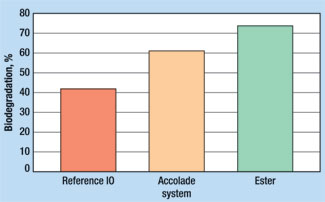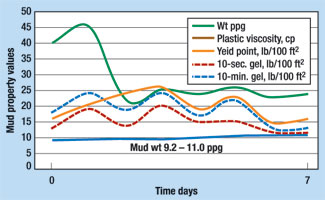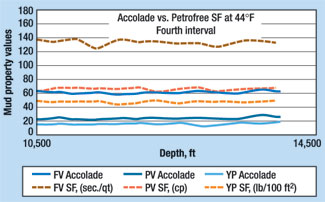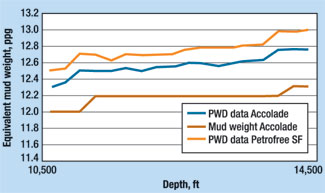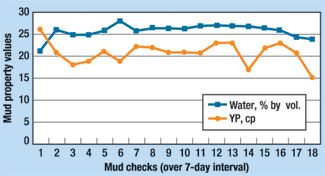New synthetic fluid system provides stable cold-temp rheologies
Drilling / Well CompletionNew synthetic fluid system provides stable cold-temperature rheologiesIn addition, it is clay-free and surpasses EPA standards. This is the story of its first field test in the Gulf of MexicoMike McFadyen, Kerr-McGee Oil & Gas Corp.; Philip J. Vice, Claude Womack and Tim Wright, Baroid Drilling Fluids, a product service line of Halliburton
Kerr-McGee Oil and Gas Corp. was the first operator in the GOM to field test a synthetic-based fluid designed specifically to comply with the new EPA standards, giving Kerr-McGee a head start in environmental protection in deepwater locations, Fig. 1. Cuttings produced while drilling with the new, proprietary clay-free Accolade system remained well within the proposed OOC limits, but the fluid can offer an equally important benefit that all deepwater operators are seeking: viscosity reduction in cold temperatures.
Background In deepwater locations, inside the lengthy marine riser, typical SBFs cool and grow viscous. Due to increased frictional pressure losses and hydrostatic pressure exerted by the mud-filled riser, the margin between pore pressure (PP) and fracture gradient (FG) diminishes as water depth increases. Viscosity climbs and so does the pump pressure needed to move the mud. Just breaking circulation can put the well at risk. Thicker fluids exert a higher equivalent circulating density (ECD) on the wellbore. Often, a tiny variation in mud weight is all that stands between drilling ahead and severe lost circulation. These were the issues that Kerr-McGee faced while drilling with the new SBF. The new fluid system contains no clay or organophilic lignites. The only powder additives are calcium chloride, lime and a fluid-loss control agent. Conventional SBFs contain organophilic clay that requires shearing to activate, and the time interval between adding clay and seeing a complete fluid response may be several hours, even several circulations. By contrast, the clay-free system’s additives are designed to act on the fluid’s emulsion phase, so that mud properties are quickly modified. Field Test The field test took place on a Green Canyon well with a 15,000-ft TD in 4,000-ft deep water. Mud density was 12.7 ppg at TD. Flowline temperatures ranged 42 to 72°F, and generally stayed between 50 and 59°F. It quickly became evident that the cold-water rheological properties of the new fluid, which remain stable over a temperature range of 40 to 120°F, were much more controllable than those of any other SBF the company had previously used. To begin the field test, water-based mud was displaced with a 9.2 ppg internal olefin (IO) SBF prior to drilling the 20-in. hole section. While drilling, the IO SBF was converted to the Accolade system over a six-day period by adding a newly-developed base oil that contained both IO and ester (EPA-compliant base oils). Although it is not necessary to start with an IO system and then convert, drilling-fluid personnel wanted to monitor the new fluid’s ability to tolerate organophilic clays and drill solids existing in the IO system. No problems with solids tolerance occurred throughout the well during the conversion. The most notable feature of the new fluid system was significantly improved rheology control, which became apparent as soon as the conversion was completed, Fig. 2. As the well depth increased and the hole diameter decreased, the clay-free fluid system continued to exhibit excellent rheological properties, Fig. 3. Data from the pressure-while-drilling (PWD) tool indicated significantly lower ECDs and a greater margin of wellbore stability, Fig. 4.
The ECD for the new system was a full 0.2 ppg lower than a concurrently running IO system. In deepwater wells, backing off 0.2 ppg on ECD can help reduce chronic mud losses caused by the small PP-FG margin. Although the new fluid is thinner than its SBF counterparts, there was no evidence of loss of suspension or barite sag throughout the well. The field test results were fully supported by extensive lab testing and modeling, using pressure-volume-temperature analysis.
Well tests fluid resiliency. Most field tests of new technology are treated like lab experiments and carried out under relatively controlled conditions. During the test described here, four additional "mud men" were on location to pilot test all proposed mud treatments, including dilution and weighting up, and to simulate the effects of naturally occurring contaminants. However, the well made most simulations unnecessary by providing its own challenges. Shortly after conversion to the new fluid system was complete, two water flows occurred. The resulting impact on rheology was slight; the yield point value decreased an average of 2 lb/100 ft2, Fig. 5. There were no visible changes in the mud from the water influx. The system also tolerated gas influxes, and the constant mud weight increases necessitated by them.
Fluid loss, filter-cake properties. Significant mud losses may occur while drilling, running casing and cementing. Such losses are not uncommon in deepwater-drilling operations, but there was some speculation that the absence of clay in the system might weaken fluid-loss control and offer less protection against whole-mud losses. However, the lower ECDs verified by the PWD tool seemed to indicate that the new system would lessen, rather than increase, the risk of losses. High pressure, high temperature fluid-loss testing showed very low spurt losses and 30-min. values of 2.0 ml or less for the majority of the well. Values above 2.0 ml occurred briefly when there were water flows into the well. Filter-cake development appeared optimal; the cake itself was indistinguishable from that of other commonly used SBFs. BOP and leak-off testing demonstrated another interesting feature of the new system. Due to compressibility of SBFs, it is usually necessary to pump the calculated volume required for testing, plus a small percentage of "bump up." According to common practice, when the initial pressure falls slightly due to compressibility, the BOP or formation is repressured, and measurements are taken at that time. Indications from the field are that the bump up is not necessary with the new system. Solids control. Solids control equipment on the rig comprised two scalper shakers, two primary shakers and a mud cleaner. There was no centrifuge. Throughout the well, low-gravity solids (LGS) measured at or below 6% by volume with one exception, where a mechanical failure allowed them to rise to 10.7%. The mud system showed no adverse affects; the PV/YP readings on the 12.3-ppg fluid at this time were 21/11. The excess LGS were rapidly removed when the equipment came back online. Compliant base oil supply and system costs. At present, the new clay-free fluid costs about $20/bbl more than the most commonly used IO SBF. However, one of the drivers for developing this new base oil is a projected industry shortage of IO, which could eventually result in an increased cost/bbl for IO SBFs. Two main IO supply sources now provide roughly 32,000 bbl of IO base oil per month for oilfield applications. Based on a probable activity level of ± 34 deepwater rigs and ± 20 shelf rigs in the GOM using synthetic fluid at any given time, the unblended supply of IO available to these rigs is only 540 bbl per rig per month. A typical deepwater operation requires as much as 4,000 bbl per month. Blending base oils will extend the supply, but any blend must comply with EPA standards – ester and IO are the only base oils to meet these standards 100%. Comparing maintenance costs between IO SBF and the new clay-free system is difficult, since the former depends on clay additions and related products, while the latter is controlled through the emulsion phase. A standard SBF emulsifier is used, along with a suite of products developed specifically for the system, including a viscosifier, a fluid-loss control agent and thinners for both cold temperatures and for the entire temperature spectrum. Based on the field test results, the system is very responsive to base-oil additions, so that adjustments requiring other additives are minimal. Conclusion Coming straight from the lab to this first trial, the new system’s trouble-free performance on a tough well is a positive indicator for more widespread use. Because it contains both IO and ester, it meets existing and proposed EPA regulations. Its consistently good rheological performance in cold temperatures can also make it an effective defense against small PP-FG margins commonly encountered in deepwater drilling. Acknowledgment The authors thank the following Accolade team members for their expertise, support and diligence in making this field test a success: Carl Albrecht, technical professional, Baroid product service line, Halliburton; Kim Burrows, technical professional, Baroid product service line, Halliburton; David Carbajal, technical professional, Baroid product service line, Halliburton; Jeff Kirsner, manager of Engineering and Development, Baroid product service line, Halliburton; Don Siems, technical advisor, Baroid product service line, Halliburton; Gary West, operations manager, Baroid product service line, Halliburton.
|
|||||||||||||||||||||||||||||||||||||||||||||||||||||||||||||||||||||||||||||||||||||||||||||||||||||||||||||||||||||||||
- Coiled tubing drilling’s role in the energy transition (March 2024)
- Using data to create new completion efficiencies (February 2024)
- Digital tool kit enhances real-time decision-making to improve drilling efficiency and performance (February 2024)
- E&P outside the U.S. maintains a disciplined pace (February 2024)
- Prices and governmental policies combine to stymie Canadian upstream growth (February 2024)
- U.S. operators reduce activity as crude prices plunge (February 2024)

